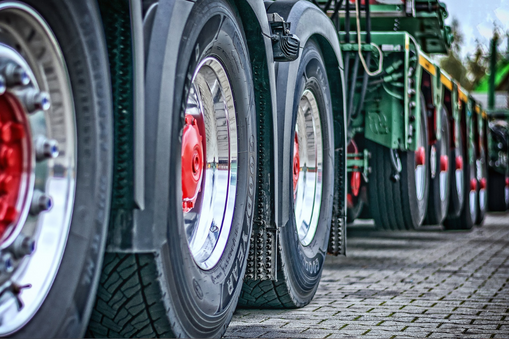A Full Guide to Understanding and Using Hydraulic cylinders for Roll-off & Dump Trucks
Hydraulic cylinders are an essential component in the functioning of roll-off and dump trucks. In these vehicles, hydraulic cylinders are used to lift and lower the dump box or the roll-off container. In this article, we will step-to-step help you fully understand and use Hydraulic cylinders for Roll-off & Dump Trucks.
What are Hydraulic Cylinders and Why are They Important for Roll-off & Dump Trucks?
Hydraulic cylinders are mechanical actuators that convert fluid pressure and flow into linear motion. They are an essential component in the functioning of roll-off and dump trucks.
In these vehicles, hydraulic cylinders are used to lift and lower the dump box or the roll-off container. They are powered by a hydraulic pump and motor, which pressurizes the hydraulic fluid and moves the piston and rod within the cylinder, causing it to extend or retract. This linear motion is used to lift the heavy load of the dump box or the roll-off container.
The use of hydraulic cylinders in roll-off and dump trucks provides several benefits, including:
Increased efficiency: Hydraulic cylinders are much faster and more efficient at lifting and lowering heavy loads compared to manual methods or other mechanical systems.
Improved safety: The use of hydraulic cylinders reduces the physical effort required to operate the vehicle, making it safer for the operator. Additionally, the hydraulic system is designed to have built-in safety features, such as pressure relief valves, to prevent overloading.
Durability: Hydraulic cylinders are designed to be durable and withstand the demanding conditions of heavy-duty trucks. They are made from high-quality materials and have strict quality control standards, ensuring their longevity and reliability.
Hydraulic cylinders are an essential component in the functioning of roll-off and dump trucks, providing increased efficiency, improved safety, and durability. Proper maintenance and use of hydraulic cylinders are crucial to ensure their long-term operation and success.
The Impact That Different Types of Oils Have on Performance and Maintenance of Your Hydraulic Cylinders
The type of oil used in a hydraulic system can have a significant impact on the performance and maintenance of the hydraulic cylinders. Here are a few of the ways that different types of oils can impact hydraulic cylinders:
Mineral oil: Mineral oil is the most commonly used type of oil in hydraulic systems due to its low cost and widespread availability. It provides good lubrication and helps to prevent wear and tear on hydraulic components, but it can also break down over time due to exposure to high temperatures, oxidation, and contamination.
Synthetic oil: Synthetic oils are man-made and can be formulated to provide specific properties and performance advantages over mineral oil. For example, synthetic oils can provide better performance at low temperatures, higher viscosity stability, and improved resistance to oxidation and thermal degradation. However, synthetic oils can be more expensive than mineral oil and may require more frequent oil changes.
Biodiesel oil: Biodiesel oil, also known as bio-based hydraulic fluid, is a type of synthetic oil made from renewable resources such as vegetable oils or animal fats. Biodiesel oil has similar properties to mineral oil and can be used in the same applications, but it is considered to be more environmentally friendly as it reduces the reliance on non-renewable petroleum-based resources. However, biodiesel oil can be more expensive than mineral oil and may have a shorter lifespan due to its lower resistance to oxidation.
Lubrication oil grades: The viscosity of a hydraulic oil is an important factor in determining its performance and effectiveness. Different viscosity grades of hydraulic oils can have different impacts on hydraulic cylinders, with lower viscosity oils providing better flow characteristics and high viscosity oils providing better wear protection.
More on Oil Types:
Oil types used in hydraulic systems are typically classified as either mineral oil or synthetic oil.
Mineral oil is a petroleum-based oil that has been refined to meet the specific needs of hydraulic systems. It is the most commonly used type of oil in hydraulic systems due to its low cost and widespread availability.
Synthetic oil, on the other hand, is man-made and can be formulated to provide specific properties and performance advantages over mineral oil. Some of the advantages of synthetic oil include improved resistance to oxidation and thermal degradation, higher viscosity stability, and better performance at low temperatures.
In terms of lubrication oil grades, hydraulic oils are usually classified according to their viscosity. The viscosity of a hydraulic oil is an important factor in determining its performance and effectiveness. The most common viscosity grades for hydraulic oils are ISO VG 32, 46, 68, and 100, where the number refers to the oil's viscosity in centistokes at 40°C.
Biodiesel oil, also known as bio-based hydraulic fluid, is a type of synthetic oil made from renewable resources such as vegetable oils or animal fats. Biodiesel oil has similar properties to mineral oil and can be used in the same applications, but it is considered to be more environmentally friendly as it reduces the reliance on non-renewable petroleum-based resources.
It's important to choose the right type of oil and viscosity grade for your hydraulic system, as using the wrong type of oil can cause damage to the components, reduce efficiency, and even result in system failure. It is recommended to consult with a hydraulic specialist or consult the manufacturer's specifications to determine the appropriate oil type and viscosity grade for your specific hydraulic system.
Hydraulic Cylinders and How to Select the Right One for Your Vehicle
hen selecting hydraulic cylinders for a roll-off or dump truck, there are several factors to consider in order to ensure that you choose the right one for your vehicle:
Type of hydraulic cylinder: There are two main types of hydraulic cylinders used in roll-off and dump trucks - tie-rod cylinders and welded clevis cylinders. Tie-rod cylinders have a threaded rod that extends from the cylinder end, while welded clevis cylinders have a welded end with a mounting plate for attaching to the dump box or roll-off container. Choose the type of cylinder that best fits the mounting requirements of your vehicle.
Bore size: The bore size of a hydraulic cylinder is the diameter of the piston, and it determines the amount of fluid that the cylinder can displace. Larger bore sizes generally provide greater lifting capacity. Choose a bore size that meets the lift requirements of your vehicle and provides enough power to lift the load.
Stroke length: The stroke length of a hydraulic cylinder is the distance that the piston travels within the cylinder. It determines the height to which the cylinder can lift the load. Choose a stroke length that provides enough lift for your vehicle and allows for adequate clearance for the load.
Rod diameter: The rod diameter is an important factor in determining the strength and durability of the hydraulic cylinder. A larger rod diameter provides greater strength and can support a heavier load. Choose a rod diameter that meets the load requirements of your vehicle and provides enough strength to handle the load.
Operating pressure: The operating pressure of a hydraulic cylinder determines the amount of force it can generate. It is important to choose a hydraulic cylinder with an operating pressure that meets the requirements of your vehicle and provides enough power to lift the load.
Mounting options: Consider the mounting options available for the hydraulic cylinder, such as clevis, eye, or flange mounting, and choose the option that best fits the mounting requirements of your vehicle.
How to Calculating Loads in Order to Choose the Appropriate Sizing of a Hydraulic Cylinder
When choosing the appropriate size for a hydraulic cylinder, it is important to consider the loads that will be placed on the cylinder and to select a cylinder that is capable of handling those loads. Here are the steps to calculate loads and determine the appropriate sizing of a hydraulic cylinder:
Determine the weight of the load: The first step in determining the appropriate sizing of a hydraulic cylinder is to determine the weight of the load that will be lifted by the cylinder. This can be done by weighing the load or by using a load calculation formula.
Determine the height of the lift: The next step is to determine the height of the lift, which is the distance that the load will be lifted by the hydraulic cylinder. This distance should be measured from the starting point of the lift to the highest point of the lift.
Determine the force required to lift the load: The force required to lift the load can be calculated using the following formula:
F = W / g
where F is the force required to lift the load, W is the weight of the load, and g is the acceleration due to gravity (9.8 m/s^2).
Determine the area of the cylinder piston: The next step is to determine the area of the cylinder piston. This can be calculated using the following formula:
A = π * (d / 2)^2
where A is the area of the cylinder piston, d is the diameter of the piston, and π is pi (3.14).
Calculate the pressure required to lift the load: The pressure required to lift the load can be calculated using the following formula:
P = F / A
where P is the pressure required to lift the load, F is the force required to lift the load, and A is the area of the cylinder piston.
Choose the appropriate size of the hydraulic cylinder: The final step is to choose the appropriate size of the hydraulic cylinder based on the pressure required to lift the load. The cylinder size should be chosen based on the maximum operating pressure of the cylinder and the pressure required to lift the load. The cylinder size should also be chosen based on the other factors discussed in the previous answer, such as stroke length, rod diameter, and mounting options.

